Automation
Dayshape harnesses the power of AI to automatically assign bookings based on your Suitability Scoring configuration. Automation can be a significant time-saver when you have large volumes of unassigned bookings to schedule.
You can run Automation when in Engagement View or in Resource View to suit your preferred Gantt mode for the scheduling task you are carrying out.
When the auto-assignment process is complete, you can view the detailed results breakdown and make further decisions on the actions needed to complete scheduling of all unassigned bookings included in the automation process.
Prior to following the procedure, described in Running On-demand Automation, please familiarise yourself with the two main tools, the Automation sidebar that contains the action buttons (top section) and detailed information on the automation process results (lower section), and the Floating Navigator that controls your main navigation and viewing experience of the suggestions.
Automation sidebar - detailed results (lower section)
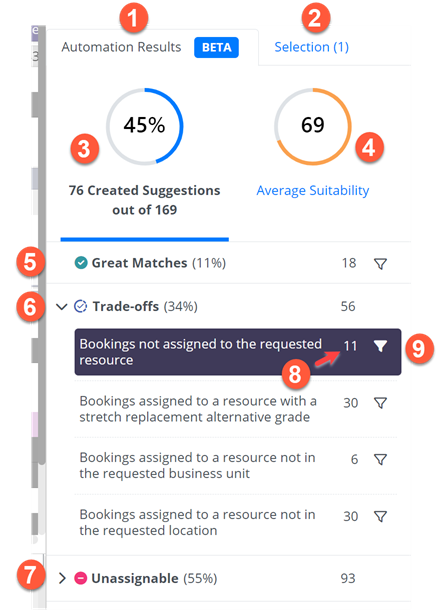
1 Automation results tab page. Allows you to easily review and navigate through what the automation tool has achieved.
2 The Selection tab page displays the selected suggestion(s) details in the same form as would normally be displayed in the Gantt sidebar when a booking (or range of bookings) is selected. From here the engagement hyperlinks operate as normal and engagement details can be checked as required:

3 Visual percentage indicator of how many suggestions were created from the total number of unassigned bookings selected for automation.
4 Visual indicator of the total average suitability achieved based on the total number of successfully created suggestions. Click Average Suitability to see a breakdown of this metric and click any of the filters to isolate suggestions in that group. Switching between the Suggestions and Average Suitability sub-tabs clears any filters you may have applied:
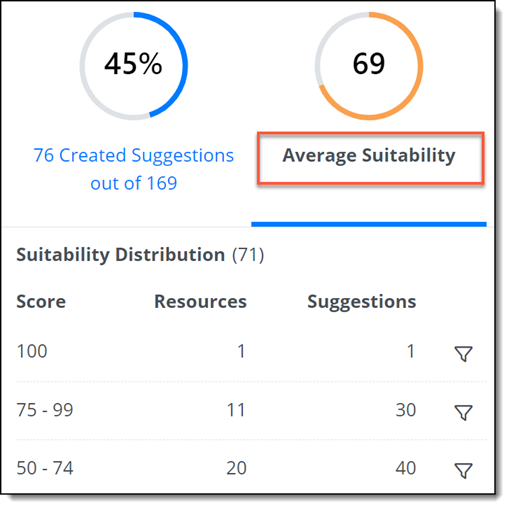
5 The first of three categories of automatically created suggestions. Great Matches are suggestions that deliver great matches based on your resource requirements, with no trade-offs. Click the filter to select these suggestions and carry out your action (usually acceptance).
6 The second of three categories of automatically created suggestions. Trade-offs are suggestions which provide the best possible matches, based on the resources loaded into your Gantt, which require further attention. These trade-offs are for example, "Bookings assigned to a resource not in the requested location". These can be viewed in their separate sub-categories (see example below) and decisions made on accepting/rejecting as appropriate. Any suggestions of this type are stamped with the Trade-off icon:

7 The last of the three categories is unassignable bookings for which On-demand Automation could not schedule for specific reasons. Click the drop-down to view more information on why these unassigned bookings were unassignable and use the filter to isolate groups within this category for further inspection. In cases where a booking is unassignable for multiple reasons, it will be grouped in the sub-category deemed the most severe. Unassignable bookings are stamped with the Unassignable icon:

8 This count shows the number of suggestions within a specific type within the category. Note that this may not be the original count, as this number decreases as you accept or reject suggestions within this sub-category. For example, automation may have created 11 suggestions where the booking is not going to be assigned to the requested resource and you have accepted 2 of them. In this case, the count would be 9. Hovering over a category will also display a tooltip that displays the original count automation came back with.
9 Click the row to activate the filter which isolates just this group of suggestions. When clicked, the Gantt’s automation colour-scheme mutes all other bookings and highlights your filtered selection. You can click the row again to clear the filter.

If you would prefer to change the automation colour-scheme (from its default setting of ‘Greyscale’), this can be done in the Gantt display Settings menu:

Automation sidebar – action buttons (top section)

1 The number of selected suggestions to which the accept/reject action will apply.
2 The Undo button allows users to undo their last accept or reject action, whether it was on a single suggestion or on a group. The example below shows that the last action was carried out on a group of 11 selected suggestions. If you wish to reset the Gantt right up until its last save, then the Cancel Changes button can be used. Note that this button will be disabled if you do not have any actions to undo.

3 Rejects the selected suggestion(s) and can be set to move to next suggestion if appropriate:

4 Accepts the selected suggestion(s) and can be set to move to next suggestion if appropriate:
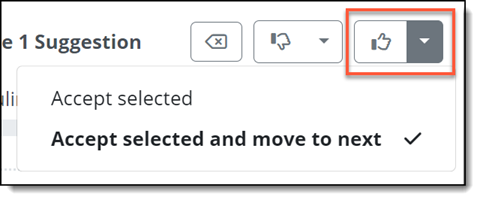
When accepting and rejecting selected suggestions or suggestion groups, you have the option to preset the corresponding buttons to carry out the action and stay where you are, which allows you to witness the accepted suggestion becoming a booking (whereas rejected suggestions are deleted).
If you select the ‘..and move to next’ option, your action is carried out and automation navigates the user to their next suggestion (or group) for decision making. If that was the last suggestion in the category, users are returned to the automation results tab page where the context reverts back to all the remaining pending suggestions.
It is important to note that in order to carry out any accept or reject action on a suggestion, you must have a valid selection. Filtering alone does not allow you to take any action.
5 Progress bar indicates number of suggestions dealt with (accepted or rejected). Hover to display a tooltip that breaks down the approve /reject actions taken:

6 The total number of suggestions created by automation (note that this can be all or a portion of the total number of unassigned bookings selected for this automation run).
Floating Navigator
The purple Gantt colour scheme and the appearance of the floating navigator at the top right of the Gantt shows that you are in automation mode:

1 Exit auto-assign mode (closes floating navigator and Gantt sidebar, and suggestions disappear)
2 Play button runs the automation process
3 Opens the Suitability Scoring setting modal
4 Can display any of the following:
-
total number of pending suggestions i.e. the number left for you to either accept or reject.
-
total number of pending suggestions within a filter, for example if you filtered to the Trade-offs, the total number of pending suggestions is what would be displayed.
When cycling through suggestions individually, you will see the specific sequence number of the selected suggestion over the total number of pending suggestions within the category you are viewing.
E.g. Suggestions: 2 out of 5
When specifically navigating to "Unassignable Bookings" the context of the nav bar will show you the total number of unassignable bookings within a filter.
Please note that the displayed count is dynamic and you will see the counts decrease in the Nav Bar as you begin accepting and rejecting suggestions.
5 Step back through suggestions, i.e. move to the previous suggestion
6 Step forward through suggestions, i.e. move to the next suggestion
7 The 'eye' icon allows users to view the Gantt with all resource rows shown, as the default state when reviewing suggestions is for resource rows to be collapsed down to only show resource rows with valid suggestions.
8 Select all pending suggestions in filtered view.
Running On-demand Automation
Prior to running Automation, we recommend you check your suitability scoring settings as Automation uses these to choose the best resources, grades, and units for assigning bookings.
-
Start the automation process by selecting Automation within the Gantt mode selector:
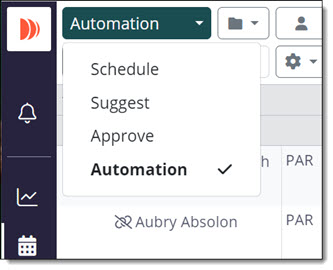
However, if you are on the Gantt in Schedule mode and select an unassigned booking (or range of unassigned bookings), the automation play button is displayed at the top of the Gantt sidebar:
-
If appropriate, check Suitability Scoring settings by selecting the Suitability icon in the floating navigator:

-
Make the necessary changes to the current Important/Recommended conditions settings and click Set. Note that you cannot disable Availability as that is a mandatory condition for On-demand Automation to run.

-
On the main Gantt, in the Unassigned Bookings pane, select the unassigned booking(s) to be automatically assigned. You can do this by drag selecting on the Gantt to highlight them, by clicking the bookings directly or by clicking the individual resource row select check-boxes. You can Shift+click for ranges or Ctrl+click on multiple individual row check-boxes to select multiple rows of unassigned bookings or click Select All.
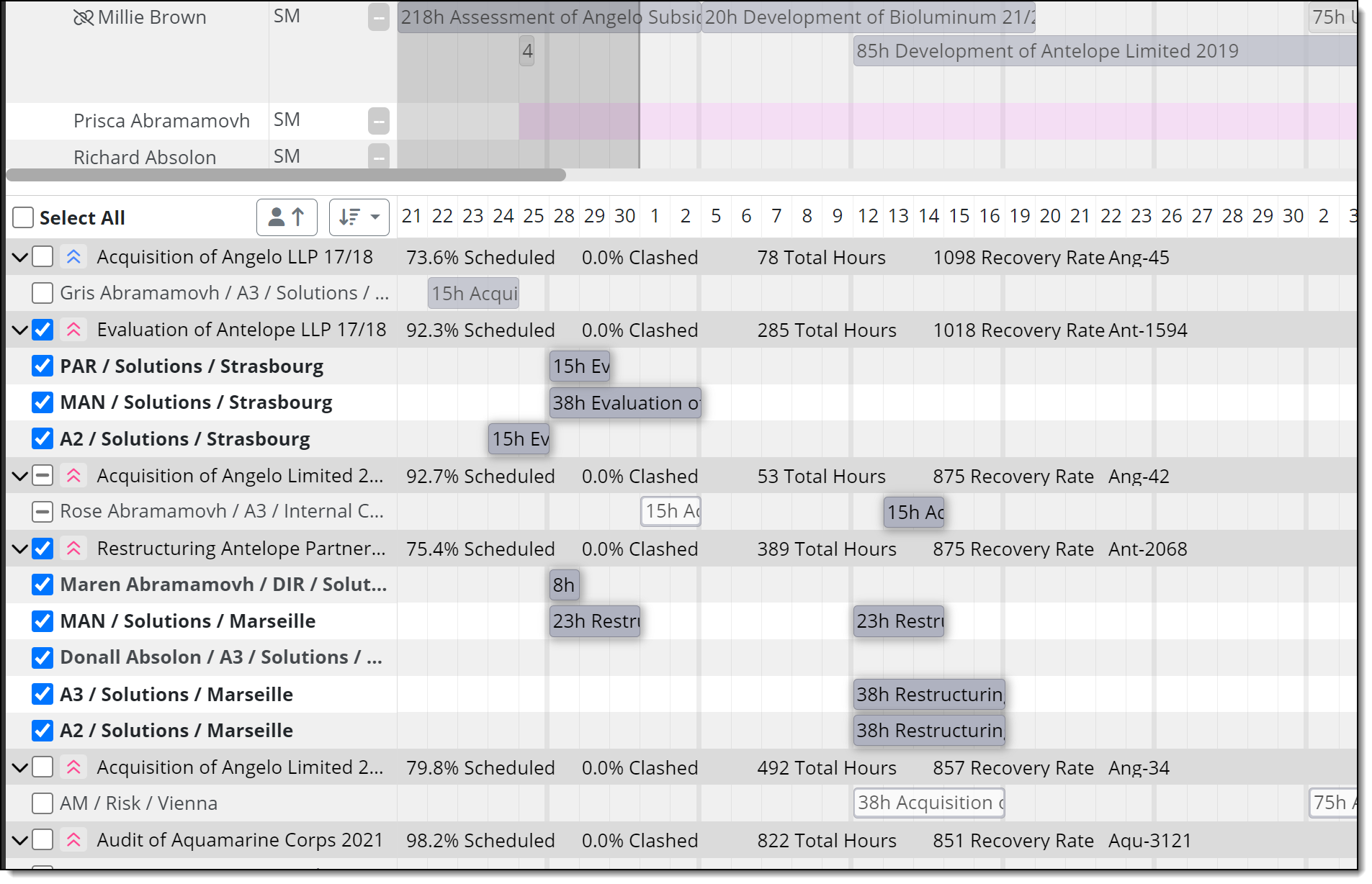
Example unassigned booking selection for automated scheduling
When in Automation mode, the Automation Play button shows when it is ready to run or is faded when in a disabled state (no unassigned Bookings selected, assigned Bookings wrongly selected or Automation is currently running):
Automation Play button (running or not ready)
Automation Play button (ready)-
Click the Play button. Dayshape informs you of progress while it attempts to automatically schedule unassigned bookings:
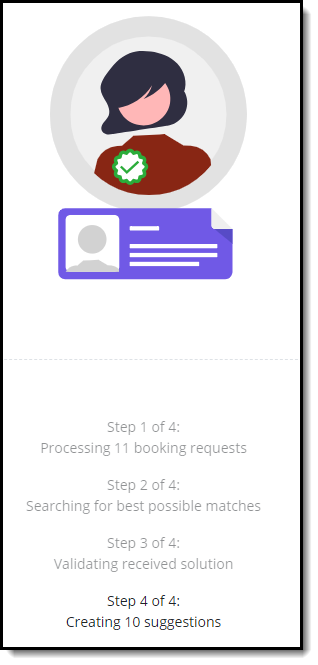
‘Live’ automation progress displayed to the user
-
The results from the automation process are displayed in the Gantt sidebar. Refer to the Automation sidebar key that explains each item and at which point in the process it can be used. Within the Automation Results tab page, the results will be displayed in three groups:
-
Great Matches - suggestions that deliver great matches based on your resource requirements, with no trade-offs. Click the drop-down to view more information on these suggestions and when selected, click the Accept icon.
-
Trade-offs - suggestions that provide the best possible matches, based on the resources loaded into your Gantt, which require further attention. Click the drop-down to view more information on these suggestions, which may be further divided into the following groups:
- Bookings not assigned to the requested resource
- Bookings used allowable overtime
- Bookings assigned to a resource with a different grade than requested
- Bookings assigned to a resource with an acceptable alternative grade
- Bookings assigned to a resource with a stretch replacement alternative grade
- Bookings assigned to a resource not in the requested functional unit
- Bookings assigned to a resource not in the requested geographical location
Filter to any of the above groups (by clicking the filter then clicking the furthest right-hand button on the Floating Navigator) to identify and view the booking(s) on the Gantt. Use the step forward and back arrows in conjunction with the Accept and Reject buttons to choose the appropriate action for each of the Trade-off suggestions or suggestion groups. When moving through Trade-off suggestions, the Unassigned pane will scroll vertically to ensure the parent engagement is within view. -
Unassignable – unassigned bookings that automation cannot assign. Click the drop-down to view more information on these unassigned bookings, which may be further divided into the following groups:
- Bookings not completely within the Gantt’s viewable time range
- Bookings that are before the current date
- Bookings which have no resources above the minimum suitability threshold
- Bookings which have no suitable resource with capacity
- Bookings which should be scheduled outside regular work hours
- Bookings which could not be auto scheduled
Filter to any of these groups to identify and view the unassigned booking(s) on the Gantt. You cannot carry out any further actions within automation for the ‘Unassignable’ type. However, you can use the information displayed to allow you to make the necessary adjustments to booking timings, dates, suitability settings (including Minimum Threshold), and loading further resources.
To assist with your adjustments to unassignable bookings, please note the rules to which On-demand Automation adheres:
• automation cannot alter the past or place suggestions at a time/date that you cannot scroll to within your Gantt view
• automation will not assign bookings that will make suitable resources breach the current Maximum Utilisation Threshold (although this setting is configurable)
• automation will only assign bookings within work hours. If a booking has been marked as being able to be outside work hours, automation would never generate a suggestion that complied with that.
-
-
When these changes have been made, you can re-run automation with these unassigned bookings reselected. Any manual changes you make to successfully assign any of the group of unassignable bookings, will be reflected in the total shown, i.e. if you manually assign two of the bookings that automation did not, the total number shown for this group will reduce by two.
-
Ensure that when all accept, reject, and cancel actions have been taken that you click Save prior to leaving the Gantt.